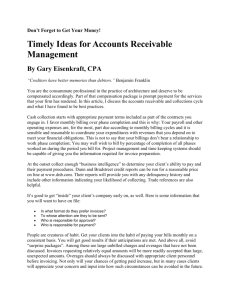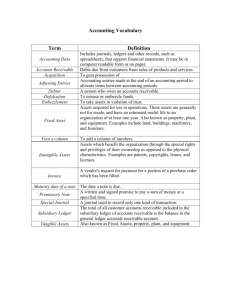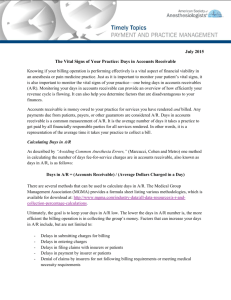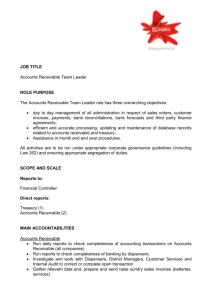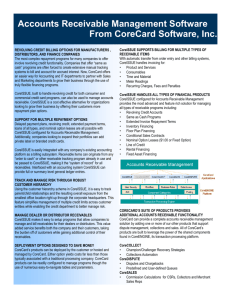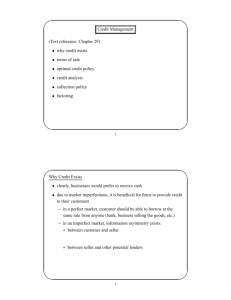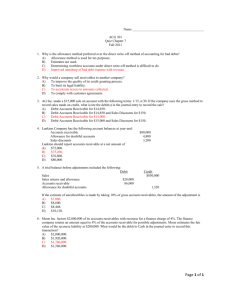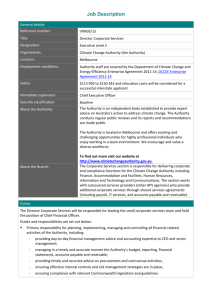Roadmap for Revenue and Receivables
advertisement
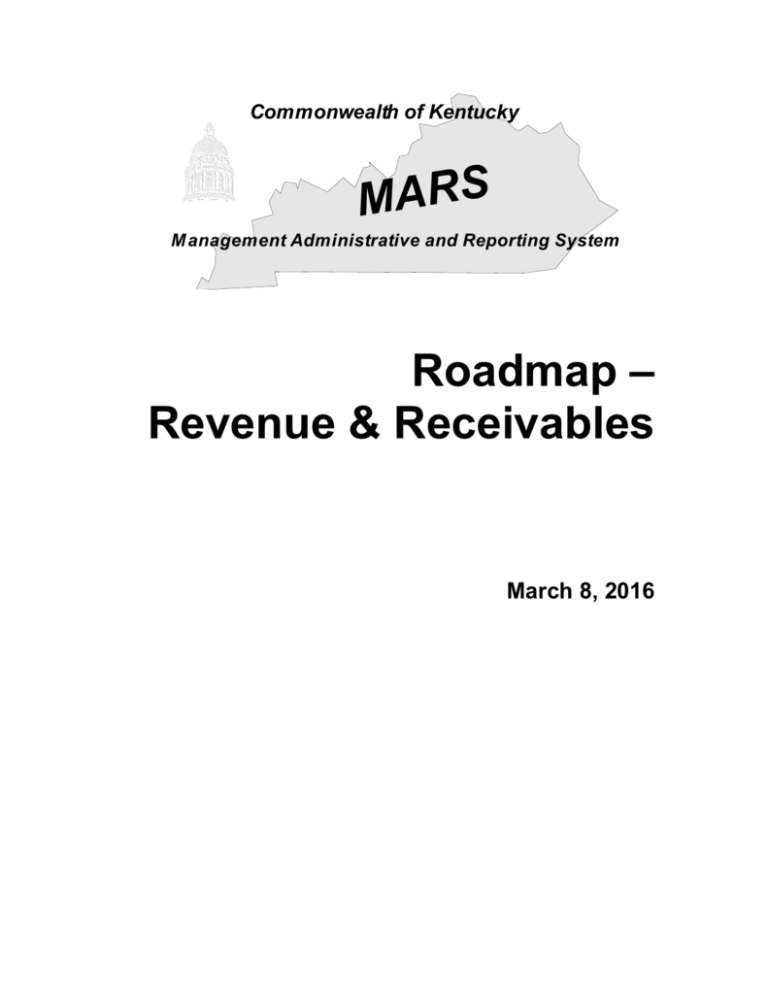
Commonwealth of Kentucky S R A M M anagement Administrative and Reporting System Roadmap – Revenue & Receivables March 8, 2016 NOTE: This document is formatted for duplex reproduction, which is the Commonwealth of Kentucky standard. Blank pages are intentionally inserted throughout the document so that the document will reproduce correctly. Commonwealth of Kentucky MARS Project Roadmap – Revenue & Receivables Table of Contents Page 1 ABOUT THIS DOCUMENT ............................................................................ 1 2 REVENUE & RECEIVABLES FUNCTIONAL AREA PROCESSES .............. 2 BILLING .......................................................................................................................................... 3 RECEIPT ........................................................................................................................................ 4 2.3 COLLECTION ....................................................................................................................... 5 2.4 CUSTOMER MAINTENANCE ................................................................................................... 7 2.5 DEPOSIT ............................................................................................................................. 8 2.6 ADJUSTMENTS..................................................................................................................... 9 2.6.1 Receivable ................................................................................................................. 9 2.6.2 Receipt ....................................................................................................................... 9 2.6.3 NSF Check ............................................................................................................... 10 3 AGENCY SETUP REQUIREMENTS ............................................................ 11 List of Tables and Figures Page TABLE 1. CENTRALIZED V. DECENTRALIZED DATA .............................................................................. 11 FIGURE 1. BILLING ............................................................................................................................. 3 FIGURE 2: CASH RECEIPT FLOWCHART ............................................................................................... 4 FIGURE 3: COLLECTION ...................................................................................................................... 5 FIGURE 4: CUSTOMER MAINTENANCE ................................................................................................. 7 FIGURE 5: DEPOSIT............................................................................................................................ 8 FIGURE 6: ADJUSTMENTS ................................................................................................................... 9 D:\106759867.doc March 8, 2016 Page i Commonwealth of Kentucky MARS Project Roadmap – Revenue & Receivables This page intentionally left blank. D:\106759867.doc March 8, 2016 Page ii Commonwealth of Kentucky MARS Project Roadmap – Revenue & Receivables 1 About This Document These Roadmaps provide a summarized document that can serve as a guiding document for Agency System Usage Analysis tasks, with the System Usage Analysis and Implementation Strategy documents serving as backup documentation when needed. Ten Roadmap documents are available, one for each business area outlined in a System Usage Analysis document. The MARS Project Business Analysis and Design team produced numerous documents available to agencies during their implementation efforts. These documents consist of two basic types: System Usage Analysis documents and Setup and Usage documents. The Business Analysis and Design team produced ten System Usage Analysis documents (available on the Internet), one for each business area: Revenue and Receivables Internal Orders and Billings Purchasing and Payables Grants and Cost Allocation Project Billing and Job Costing General Accounting Inventory Fixed Assets Budget Preparation Disbursements Six Setup and Usage documents (also available on the Internet) were produced: Materials Management Setup and Usage Strategy Accounts Payable/Accounts Receivable Redesigned Process Implementation Strategy Budget Setup and Implementation Analysis Chart of Accounts Plan Cost Classification and Reporting Plan Source Document & Transaction Mapping Analysis Generally, these documents contain detailed information about the key business processes and system component setup, and most are fairly large documents. Recognizing that these materials can be overwhelming for agencies to digest, the MARS Implementation Team has taken these materials and condensed both the System Usage Analysis business process information and the Setup and Usage information into Roadmap documents. Each Roadmap consists of two major sections: 1. Functional Area Processes. This section provides an introduction, and information regarding key business process. An overview is given for each process, and diagram is provided where applicable. 2. Agency Setup Requirements. Where applicable, this section summarizes key agency setup requirements and data elements. In addition, some Roadmaps provide data structure diagram for applicable components of the system. These setup requirements work in conjunction with the Data Prep and Setup section (section 6.8) of the Agency Implementation Notebook. D:\106759867.doc March 8, 2016 Page 1 Commonwealth of Kentucky MARS Project Roadmap – Revenue & Receivables 2 Revenue & Receivables Functional Area Processes Revenue is defined as income to the Commonwealth that is recorded as an income statement account, for example, tax collection, and income earned for goods and services provided. A Receivable event is an event known to have occurred resulting in a sum of money being due to the Commonwealth. For example, a fine due to violation of a government regulation that is owed to the Commonwealth. Revenue can be recognized at the time goods and services are provided and a receivable event is recorded. Revenue can also be recognized when money (i.e., cash, check or EFT deposit) is received and a receipt is recorded. The Advanced Receivable Subsystem (ARS) will be used to provide MARS Receivable functionality. The ARS records detailed receiavable transactions. The subsystem supports both cash and accrual basis accounting. Transactions are posted to on-line tables (e.g., Open Receivable Header Inquiry (OREH) and Open Receivable Line Inquiry (OREL), etc.) and the revenue ledger. The RR team determined that some current accounts receivable subsystems will exist external to MARS (Revenue Cabinet, Transportation Cabinet, etc.). MARS will not replace these agency systems due to the other necessary information that is housed in the subsystems. Six processes were identified within the Revenue and Receivable function: 1. 2. 3. 4. 5. 6. Billing. Receipt. Collection. Customer Maintenance. Deposit. Adjustment. D:\106759867.doc March 8, 2016 Page 2 Roadmap – Revenue & Receivables Commonwealth of Kentucky MARS Project 2.1 Billing Pre-billing event Customer file Initiate receivable document Verify and approve receivable accounting information Approve and Approve and process process receivable receivable document transaction MARS open receivable tables Print invoice Print invoice Mail Figure 1. Billing The Billing process records and tracks receivable events in MARS. Invoices are sent to customers as a result of the billing process. The Billing event is triggered by a pre-billing event, which comprises the order of goods and services and/or fulfillment of order, traffic violation, etc. The Billing process records amount legally owed to the Commonwealth. It can be a revenue event if goods and services are provided; it can be a vendor refund owed to the Commonwealth; or it can be unearned revenue. The recording of the Billing event will be primarily performed by agencies in a decentralized environment. Agencies initiate the data entry, obtain approvals from the agency authority and process the billing. As a result, an agency may elect to print invoices at the agency site rather than centrally, and sent the invoice to the customer. Optionally, the customer statement is also generated and mailed. While agencies are responsible to track their own receivables, Central Finance will also be able to monitor at the statewide level via on-line inquiry and reports. For agencies using their own accounts receivable subsystems, summary receivable information will be sent from the offline system and recorded as an accounting event in MARS. Invoices are not produced for these summary receivables. D:\106759867.doc March 8, 2016 Page 3 Roadmap – Revenue & Receivables Commonwealth of Kentucky MARS Project 2.2 Receipt Sorted Sorted mails mail Agency Open receivables Initiate receipt transaction Prepare transmittal list Customer file Approve and Approve and route route to to Treasury Treasury Treasury Verify amount and approve receipt transaction Treasury tables Create Deposit Ticket Update deposit date Bank Deposit money Optional Figure 2: Cash Receipt Flowchart D:\106759867.doc March 8, 2016 Page 4 Roadmap – Revenue & Receivables Commonwealth of Kentucky MARS Project The Receipt process will be initiated by the agencies that receive money and completed by the Treasury who deposits the money into the bank. The timing is critical for this process. When a receivable is referenced on a cash receipt document, from the time agencies receive the money until Treasury processes the cash receipt document, the customer receivable will stay open. In addition, money should not be available for agencies to spend until the Treasury deposits it. Online inquiries provide the ability to track which receivables the customer has paid and which are still outstanding. The MARS security setup should ensure that agencies only see their own transactions online. In the situation when one customer’s check pays cross agency invoices and there is not sufficient information on which receivables the check is paying for, a central office who has access to all agencies’ receivables should take the responsibility to track down the missing information. 2.3 Collection Dunning message Agency Potential Uncollectible Receivable (PUNR table) Collection letters A ging report -A ging report - past past due due receivables receivables Collection process Flexible payment scheduling No V endor? Write of f Y es Intercept process Collection agency Figure 3: Collection D:\106759867.doc March 8, 2016 Page 5 Commonwealth of Kentucky MARS Project Roadmap – Revenue & Receivables The collection process comes into play when the receivables become past due. Based on the number of days past due, different messages (e.g., dunning messages, collection letters) will be sent to remind the customer of the amount owed to the Commonwealth. Dunning messages are sent for past due receivables. If desired, collection letters may be sent for significantly past due receivables. Agencies will define the content of the dunning messages and collection letters on the dunning message (DUNN) and collection letters (COLT) tables. The scheduling of the messages and letters is defined on the Collection Control (CCTL) and Billing Profile Collection Cycle (BPCC) tables. On the appropriate day past due, the respective dunning message is printed on the invoice during the normal invoice print process. Dunning messages can be printed on-demand to a local printer or by batch. Collection letters will be printed by batch during the nightly cycle. Optionally, interest and/or late charges will be applied to the customer’s billing. The interest and late charge accrual is calculated based on parameters (e.g., interest rate, interest type, late charge amount). These data elements are defined in the system-wide Revenue Options (ROPT) or Revenue Options by Agency/Revenue Source (ROAR). Different collection events are listed below: Accrue interest and apply late charges. Arrange alternative payment scheduling. Write off. Intercept. Handle a NSF check. MARS provides capability for agencies to arrange flexible payment scheduling within the guidelines established by the Central Finance. The flexible payment scheduling can be established by using the Payment Scheduling (PSHD) table. A customer’s receivable can also be written off when it is evident that the collection is highly unlikely. The write-off of a receivable is scheduled on the Potential Uncorrectable Receivable (PUNR) table. A write-off transaction will be automatically generated in the nightly cycle to reverse the receivable entries. In the situation when a customer is also a vendor, payments from the Commonwealth paying to the vendor can be intercepted up to the amount of the past due receivable. These past due receivables must be established in the Warrant Intercept (WINT) table. A Vendor Offset (VO) transaction will be automatically created and update the Debtor Vendor (DVND) table with the receivable claim information. For NSF checks returned to the Treasury, Treasury will initiate the recording of the event. If a receivable number is on the face of the check, Treasury will use the Non-Sufficient Fund (NF) document. If a cash receipt number is on the face of the check, Treasury will process a decrease cash receipt transaction. To debit the correct individual revenue account for the NSF check, agencies will use a journal voucher (JVM) document to make adjustments. NSF checks received by the field office will be recorded and processed by the field office using a NF document or decrease CR document. D:\106759867.doc March 8, 2016 Page 6 Roadmap – Revenue & Receivables Commonwealth of Kentucky MARS Project 2.4 Customer Maintenance Agency Agency initiates customer document SUSF file w orkflow w orkflow notification Finance Verify, approve and process customer document Customer file Figure 4: Customer Maintenance The Customer Maintenance process includes the following activities: Establish a customer record. Change a customer record. Inactivate a customer. Mark a customer in dispute or in legal action. Delete a customer. Maintain an audit trail. The Commonwealth’s vision for the Customer database is to keep it as up-to-date as possible, with the most accurate information. The establishment and maintenance of customer records are shared activities between agencies and Central Finance. Agencies will initiate any new customer and changes to an existing record through the use of the Customer (CU) document. This document will be routed through workflow to Central Finance. Central Finance will approve and update the customer records. Once the document is processed, the workflow will notify the agencies. Additionally, the Commonwealth would like to keep the size of the database at an optimal level and delete those customers that no longer conduct business with the Commonwealth. Customers should be inactivated and/or deleted based on user-defined parameters. Examples of the parameters would include time limits for placing orders, receiving payments, or any other type of customer activity. These parameters would be used to mark the customer as inactive, mark the customer to be deleted, automatically inactivate a customer, and automatically delete. D:\106759867.doc March 8, 2016 Page 7 Roadmap – Revenue & Receivables Commonwealth of Kentucky MARS Project The tracking of the customer balances will be performed at both agency level and central/statewide level. For agencies, online inquiry capability will allow them to track customer balances that are only relevant to their own agencies’ business events (e.g., Open Receivables by Customer (OREC) table). For example, agency A will not see agency B’s detail transactions and balances for the same customer. On the other hand, Central Finance will see customer balances at statewide level (i.e., Customer Credit History (CUSC) table and Customer Financial History (CUSF) table). 2.5 Deposit Agency $$$$ Agency initiates CR document Treasury Verify, approve and process CR document Deposit ticket Treasury Cash Receipt table Bank Local bank deposit Farmer's bank deposit Figure 5: Deposit The Deposit process is the same as the Receipt process for the agencies that deposit the money into Farmer’s bank through the Treasury. In some instances, agencies deposit the money D:\106759867.doc March 8, 2016 Page 8 Roadmap – Revenue & Receivables Commonwealth of Kentucky MARS Project into a local bank account and then transfer the money to the Farmer’s bank account. A journal voucher is initiated by the local office and posted by the Treasury for the transfer. 2.6 Adjustments Bank statement External and internal discrepancies Investigate and research discrepancies MARS on-line Inquiry Adjustment document Updated table and ledgers Figure 6: Adjustments The Commonwealth’s vision for the adjustment process is that only properly authorized adjustments will be made. The Adjustments process includes all adjustments to a transaction – adjustments to a receivable transaction, adjustments to a receipt transaction, etc. Approval process should be the same for adjustments as for the original transactions. The following lists some examples of adjustments: 2.6.1 2.6.2 Receivable Increase/decrease a receivable amount by processing a modifying Receivable (RE) or Receivable Credit Memo (RM) document. Change the revenue account the receivable is applied to by processing a Journal Voucher Correction (JVC) document. Receipt Increase/decrease a receipt amount by processing a modifying cash receipt (CR or C1) document. Change the referenced receivable for the receipt by processing a modifying cash receipt (CR or C1) document. D:\106759867.doc March 8, 2016 Page 9 Commonwealth of Kentucky MARS Project 2.6.3 Roadmap – Revenue & Receivables Change the revenue account the receipt is applied to by processing a JVC document. NSF Check Reverse the NF transaction by processing a Receivable Credit Memo (RM) document and creating a cash receipt transaction. Reverse the decrease CR transaction by processing a modifying cash receipt document. D:\106759867.doc March 8, 2016 Page 10 Commonwealth of Kentucky MARS Project Roadmap – Revenue & Receivables 3 Agency Setup Requirements To process accounts receivable transactions, reference data, system controls and options must be set up before hand. These are the tasks of System Administrators. Since MARS provides both decentralized transactions processing and centralized controls, system administration is handled by both Central Finance and agencies. This data is categorized into the following areas: Central System Administration – this data will be established by the Central Implementation team and entry and ongoing maintenance will be handled by central administration. Agency Administration – this data will be established by the Agency Implementation teams and entry and ongoing maintenance will be handled by agency administrators. Central Administration with Agency Input – responsibility will be shared between Central Finance and the agencies. For example, agencies will enter the customer information and the Central Finance will approve the data and post it to the central customer file. In other instances, one table requires entries and maintenance by both Central Finance and agencies. Table 1lists the breakdown of centralized v. decentralized data (tables): Table 1. Centralized v. Decentralized Data Central System Administration Revenue Options (ROPT) Receivable Due Date Lag Tolerance Level for Over/Underpayment BS Accounts for Overpayment Revenue Source for NSF Charge, Late Charge, Interest Charge Late Charge Finance Accumulation Type Interest Type Dunning Message & Collection Letter Control (CCTL) Agency Administration Revenue Options by Agency and Revenue Source (ROAR) Finance Accumulation Type Interest Type Late Charge NSF Charge Tolerance Level for Over/Underpayment Both Customer (CU) Third Party Billing (TPAR) Receivable Adjustment Reason Code (REAR) Billing Profile (BPRO) Billing Rate (BRTE) Dunning Message (BPCC, DUNN) Collection Letter (BPCC, COLT) Renewal Notice (RNTP, RTXT) For detailed setup and usage information, see the Accounts Payable and Accounts Receivable Redesigned Process Implementation Strategy document. D:\106759867.doc March 8, 2016 Page 11
